Insert a video from YouTube or another site

In PowerPoint for Microsoft 365, PowerPoint 2021, or PowerPoint 2019, you can insert an online video from YouTube or Vimeo on a slide.
In PowerPoint for Microsoft 365, version 1907 or later, you can also insert an online video from Microsoft Stream, a video service for enterprises—people in an organization can upload, view, and share videos with one another.
The video plays directly from the website, and it has the site's controls for playing, pausing, volume, and so on. The PowerPoint playback features (Fade, Bookmark, Trim, and so on) don't apply to online videos.
Because the video is stored on a web site, rather than in your presentation, you must be connected to the internet in order for the video to play successfully.
Insert a web video
-
In your web browser, locate the video you want.
-
Copy the URL of the web page from the Address bar of your browser.
-
Switch back to PowerPoint and select the slide where you want to place the video.
-
On the Insert tab of the ribbon, select Video > Online Video.
-
In the Online Video dialog box, paste the URL you copied in step 2.
-
Select Insert.
Play the video
If a video is inserted successfully, you can play it either in Normal view or Slide Show.
-
A Play button appears on the video in Normal view.
-
In Slide Show, you can interact with videos just as you would in a web browser.
-
By default, videos from YouTube and Vimeo play in "click sequence." You can play the video without having to click the Play button. Just tap the spacebar to advance to the next step in your click sequence.
Troubleshooting
Not all online videos from these sites are allowed to be embedded. You should check on the video site to find out if a certain video can be embedded.
Internet Explorer 11 is required on your computer
Note: Microsoft 365 apps and services will not support Internet Explorer 11 starting August 17, 2021. Learn more. Please note that Internet Explorer 11 will remain a supported browser. Internet Explorer 11 is a component of the Windows operating system and follows the Lifecycle Policy for the product on which it is installed.
For the purpose of playing videos in PowerPoint, Internet Explorer 11 is required to be on your computer. You don't have to use it to browse the web; you simply have to have it installed, because under the covers, PowerPoint needs its technology to play videos on Windows.
If your operating system is Windows 10, then you already have Internet Explorer 11 installed. If you have an older version of Windows, you can go to this Internet Explorer Downloads page for instructions.
Want to insert a video from your computer instead?
See Insert and play a video file from your computer for all the details.
Terms of Use and Privacy policies
Vimeo:
YouTube:
Microsoft Stream:
SlideShare.net:
In PowerPoint 2016, you can insert an online video with an embed code or search for a video by name. Then you can play it during your presentation.
The video plays directly from the website, and it has the site's controls for playing, pausing, volume, and so on. The PowerPoint playback features (Fade, Bookmark, Trim, and so on) don't apply to online videos.
Because the video is stored on a web site, rather than in your presentation, you must be connected to the internet in order for the video to play successfully.
Insert the online video with an "embed" code
-
On YouTube or Vimeo, find the video that you want to insert.
-
Below the video frame, click Share, and then click Embed. (If you neglect to click Embed, you'll end up copying the wrong code.)
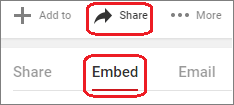
-
Right-click the iFrame embed code, and click Copy.
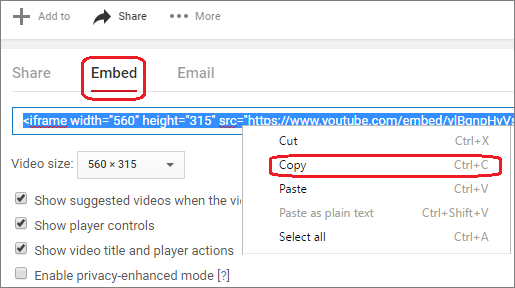
If the highlighted text that you copy begins with "http", STOP. It's the wrong code to copy. Return to step 2 and click Embed:
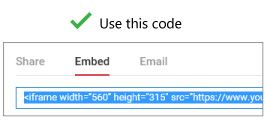
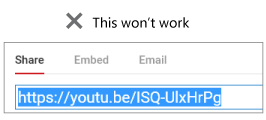
-
In PowerPoint, click the slide that you want to add a video to.
-
On the Insert tab, click Video > Online Video.
-
In the From a Video Embed Code box, paste the embed code, and then click the arrow.
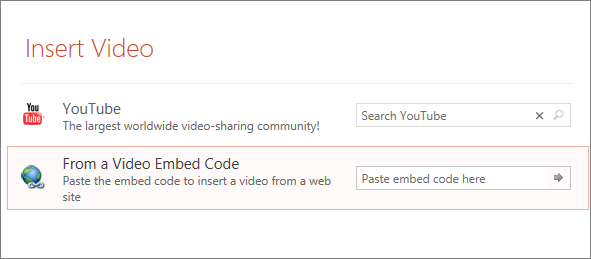
-
A video rectangle is placed on your slide, which you can move and resize as you like. To preview your video on your slide, right-click the video rectangle, select Preview, and then click the Play button on the video.
Note: If your video doesn’t embed correctly, double-check that you have installed the required Office updates.
Search for the YouTube video by name
-
Click the slide that you want to add a video to.
-
On the Insert tab, click Video > Online Video.
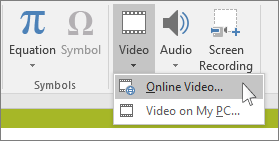
-
In the Search YouTube box, type the name of the video that you want to insert, and press Enter.
-
Select the video from the search results, and click Insert.
-
A video rectangle is placed on your slide, which you can move and resize as you like. To preview your video on your slide, right-click the video rectangle, select Preview, and then click the Play button on the video.
Note: If your video doesn’t insert correctly, double-check that you have installed the required Office updates.
Preview the video
-
Once the video rectangle is on your slide, select it, right-click it and choose Preview.
A Play button appears on the video.
-
Click the video's Play button.
Because the video is on a web site, rather than actually in your presentation, you must be connected to the internet in order for the video to play successfully.
Internet Explorer 11 is required on your computer
Note: Microsoft 365 apps and services will not support Internet Explorer 11 starting August 17, 2021. Learn more. Please note that Internet Explorer 11 will remain a supported browser. Internet Explorer 11 is a component of the Windows operating system and follows the Lifecycle Policy for the product on which it is installed.
For the purpose of playing videos in PowerPoint, Internet Explorer 11 is required to be on your computer. You don't have to use it to browse the web; you simply have to have it installed, because under the covers, PowerPoint needs its technology to play videos on Windows.
If your operating system is Windows 10, then you already have Internet Explorer 11 installed. If you have an older version of Windows, you can go to this Internet Explorer Downloads page for instructions.
Want to insert a video from your computer instead?
See Insert and play a video file from your computer for all the details.
Embed content from Slideshare.net
On a slide in PowerPoint, you can embed content from Slideshare.net, a sharing web site for presentations, infographics, and documents.
On Slideshare.net, any content that can be embedded elsewhere has a Share button on it. That button opens a window where you can copy an embed code like an embed for a video.
-
On Slideshare.net, find the content you want to embed.
-
Select the Share button beneath the content frame.
Sharing codes appear in the video frame.
-
Select the box named Embed.
All the text in the box becomes selected when you do this.
-
Right-click the selected text and choose Copy.
The text you've copied contains more information than you need, so it needs to be trimmed and re-copied.
-
Paste the copied text into a text editor such as Word or Notepad.
-
Select the portion of the text that begins with <iframe src ... and ends with </iframe>. Copy that text.
That's the embed code you need for inserting the content into PowerPoint.
-
In PowerPoint, go to the slide where you want to insert the content.
-
On the toolbar ribbon, select the Insert tab, select Video, and then select Online Video.
The Insert Video dialog box opens.
-
Paste the embed code in the box named From a Video Embed Code, and then press Enter.
It takes a moment for PowerPoint to absorb the content. When it has done so, a black box appears on your slide.
-
To view the content, select the Slide Show button

Requirements
Your use of online videos is subject to each provider web site's Terms of Use and Privacy Policy.
-
SlideShare.net
-
Vimeo
-
YouTube
Web
In PowerPoint for the web, you can insert an online video from YouTube or Vimeo on a slide. (If you have a Microsoft 365 business or education subscription, you can also insert an online video from Microsoft Stream.)
The video plays directly from the website, and it has the site's controls for playing, pausing, volume, and so on. The PowerPoint playback features (Fade, Bookmark, Trim, and so on) don't apply to online videos.
Because the video is stored on a web site, rather than in your presentation, you must be connected to the internet in order for the video to play successfully.
Insert an online video
-
On a separate tab in your web browser, locate the video you want.
-
Copy the address of the web page from the Address bar of your browser.
-
Switch to PowerPoint for the web and select the slide where you want to place the video.
-
On the Insert tab of the ribbon, in the Media group, select Online Video.
-
In the Online Video dialog box, paste the address you copied in step 2.
-
Select Insert.
The video is inserted on your slide. You can move the video by dragging with the mouse, and you can resize the video frame by selecting a corner and dragging.
-
To play the video, you must run Slide Show. On the ribbon, switch to the View tab, and in the Start Slide Show group, select From Current Slide.
(If you've turned off the Simplified Ribbon, you don't have a Slide Show tab; instead use the View tab to start the slide show.)
Slide Show opens, and then you can click the play button to begin.
For related information, see Play a video in PowerPoint for the web.
Your use of online videos is subject to each provider web site's Terms of Use and Privacy Policy.
-
Microsoft Stream:
-
Vimeo:
-
YouTube:
Trimming a video
PowerPoint for the web can't trim videos, and online videos can't be trimmed. If you have a video that you want to trim, you must save it to your computer, then insert it on your slide in a desktop version of PowerPoint.
Newer Mac versions
In PowerPoint for Microsoft 365 for Mac, PowerPoint 2021 for Mac, or PowerPoint 2019 for Mac, you can insert an online video from YouTube or Vimeo on a slide. Earlier versions of PowerPoint for macOS don't support inserting an online video.
In PowerPoint for Microsoft 365 for Mac, you can also insert an online video from Microsoft Stream, a video service for enterprises—people in an organization can upload, view, and share videos with one another. This feature requires PowerPoint for Microsoft 365 for Mac version 16.27 or later.
The video plays directly from the website, and it has the site's controls for playing, pausing, volume, and so on. The PowerPoint playback features (Fade, Bookmark, Trim, and so on) don't apply to online videos.
Because the video is stored on a web site, rather than in your presentation, you must be connected to the internet in order for the video to play successfully.
Insert a web video
-
In your web browser, locate the video you want.
-
Copy the URL of the web page from the Address bar of your browser.
-
Switch to PowerPoint and select the slide where you want to place the video.
-
On the Insert tab of the ribbon, in the Media group at the right end, select Video. Then select Online Movie.
-
In the dialog box, paste the URL you copied in step 2.
-
Click Insert.
The video is added to the slide.
-
To preview the video, click the Play button that appears on top of video.
Want to insert a video from your computer instead?
See Insert and play a video file from your computer for all the details.
Requirements
Inserting and playing an online video requires a recent version of macOS and PowerPoint for macOS:
-
PowerPoint version 16.15.18070902 or later
-
macOS 10.13.4 (High Sierra) or later
-
A Mac manufactured in 2012 or later
Your use of online videos is subject to each provider web site's Terms of Use and Privacy Policy.
-
Microsoft Stream:
-
Vimeo:
-
YouTube:
-
SlideShare.net:
See Also
Why can’t I embed a video in PowerPoint?
Add audio to your presentation
Video and audio file formats supported in PowerPoint










